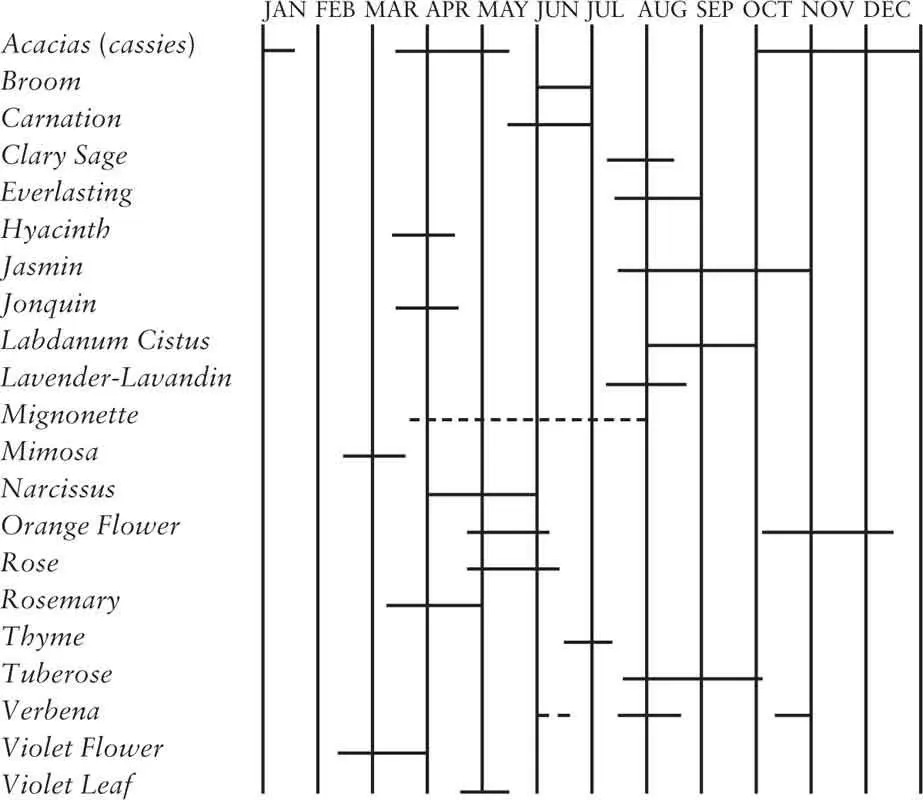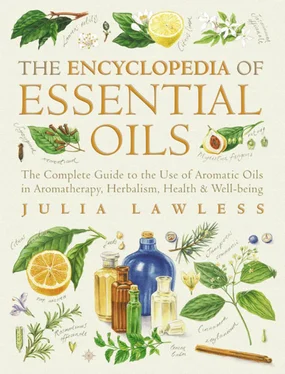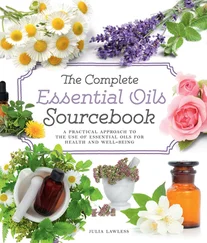Most concretes contain about 50 per cent wax, 50 per cent volatile oil, such as jasmine; in rare cases, as with ylang ylang, the concrete is liquid and contains about 80 per cent essential oil, 20 per cent wax. The advantage of concretes is that they are more stable and concentrated than pure essential oils.
Resinoids are prepared from natural resinous material by extraction with a hydrocarbon solvent, such as petroleum ether or hexane. In contradistinction to concretes, the resinoids are prepared from dead organic material, whereas concretes are derived from previously live tissue. Typical resinous materials are balsams (Peru balsam or benzoin), resins (mastic and amber), oleoresins (copaiba balsam and turpentine) and oleo gum resins (frankincense and myrrh). Resinoids can be viscous liquids, semi-solid or solid, but are usually homogeneous masses of non-crystalline character. Occasionally the alcohol-soluble fraction of a resinoid is called an absolute.
Some resinous materials like frankincense and myrrh are used either to make an essential oil by steam distillation or a resin absolute by alcohol extraction directly from the crude oleo gum resin. Benzoin, on the other hand, is insufficiently volatile to produce an essential oil by distillation: liquid benzoin is often simply a benzoin resinoid dissolved in a suitable solvent or plasticizing diluent.
Like concretes, resinoids are employed in perfumery as fixatives to prolong the effect of the fragrance.
An absolute is obtained from the concrete by a second process of solvent extraction, using pure alcohol (ethanol) in which the unwanted wax is only slightly soluble. An absolute is usually subjected to repeated treatment with alcohol; even so, as is the case with orange flower absolute, a small proportion of the wax remains. Absolutes can be further processed by molecular distillation which removes every last trace of non-volatile matter. The alcohol is recovered by evaporation which requires a gentle vacuum towards the end of the process. Some absolutes, however, will still retain traces of ethyl alcohol, at about 2 per cent or less, and are not recommended for therapeutic work because of these impurities.
Absolutes are usually highly concentrated viscous liquids, but they can in some cases be solid or semi-solid (clary sage absolute). In recent years, much research has been devoted to the extraction of essential oils and aromatic materials using liquid carbon dioxide; oils produced in this manner are of excellent odour quality and are entirely free of unwanted solvent residues or non-volatile matter.
True pomades are the products of a process known as enfleurage, which is virtually obsolete today. This was once the principal method for obtaining aromatic materials from flowers that continued to produce perfume long after they were cut. A glass plate was covered in a thin coating of specially prepared and odourless fat, called a chassis . The freshly cut flowers, such as jasmine or tuberose, were individually laid in the fat which became saturated with their volatile oils. The chassis would be frequently renewed with fresh material throughout the harvest. Eventually the fragrance-saturated fat, known as pomade, would be treated by extraction with alcohol to produce the pure absolute or perfume.

Periods of the year for the treatment of various flowers once grown in Provence, France
Natural versus ‘Nature Identical’
Many perfumes or oils, once obtained from flowers such as carnation, gardenia and lilac, are nowadays produced almost entirely synthetically. In the pharmaceutical industry these chemically constructed products are called ‘nature identical’. The perfumery and flavouring industries require continuity in their products and naturally occurring substances are always subject to change, due to seasonal conditions. However, the so-called ‘nature identical’ products and the naturally occurring essential oils are of an entirely different character, which is reflected in their relative costs – the synthetic types being much cheaper to produce than the genuine ones. Many aromatic oils, such as lavender or geranium, contain a relatively small number of major constituents, several minor constituents and also a very large number of trace elements. To reconstruct such a complex combination of components including all the trace elements, would be virtually impossible. Most ‘nature identical’ oils are said to be only about 96 per cent pure or accurate, yet it is the remaining 4 per cent, the trace elements, that often really define a particular fragrance. Such is the case with galbanum oil where the pyrazines, present at rather less than 0.1 per cent, are responsible for the powerful green odour of the oil.
It is also the specific combination of constituents in a real essential oil, including the trace elements, which give it value therapeutically. The reason for this might be that these minute amounts of trace elements have a synergistic or controlling effect on the main ones. For example, there are over 300 different constituents in rose, some of which have not yet been identified, which is why synthetic rose oil is unconvincing. ‘Nature identical’ oils cannot be used therapeutically as substitutes for the naturally occurring aromatic materials, not only because the subtle balance of constituents is lost but also because they lack the vital ‘life force’ of oils of natural origin.
Part II THE OILS
Trachyspermum copticum
FAMILYApiaceae (Umbelliferae)
SYNONYMS T. ammi, Ammi copticum, Carum ajowan, C. copticum, Ptychotis ajowan, ajuan, omum.
GENERAL DESCRIPTIONAn annual herb with a greyish-brown seed, which resembles parsley in appearance.
DISTRIBUTION Chiefly India, also Afghanistan, Egypt, the West Indies and the Seychelle Islands.
OTHER SPECIES see Botanical Classificationsection.
HERBAL/FOLK TRADITION The seeds are used extensively in curry powders and as a general household remedy for intestinal problems. The tincture, essential oil and ‘thymol’ are used in Indian medicine, particularly for cholera.
ACTIONS Powerful antiseptic and germicide, carminative.
EXTRACTION Essential oil by steam distillation from the seed.
CHARACTERISTICS A yellow-orange or reddish liquid with a herbaceous-spicy medicinal odour, much like thyme.
PRINCIPAL CONSTITUENTS Thymol, pinene, cymene, dipentene, terpinene and carvacrol, among others.
SAFETY DATA Possible mucous membrane and dermal irritant. Due to high thymol level, should be avoided in pregnancy. Toxicity levels are unknown.
AROMATHERAPY/HOME USE Not recommended.
OTHER USES It has been used extensively for the isolation of thymol, but this has largely been replaced by synthetic thymol.
Pimenta dioica
FAMILYMyrtaceae
SYNONYMS P. officinalis, pimento, pimenta, Jamaica pepper.
GENERAL DESCRIPTIONAn evergreen tree which reaches about 10 metres high and begins to produce fruit in its third year. Each fruit contains two kidney-shaped green seeds which turn glossy black upon ripening.
DISTRIBUTIONIndigenous to the West Indies and South America, it is cultivated extensively in Jamaica, Cuba and, to a lesser degree, in Central America. Imported berries are distilled in Europe and America.
Читать дальше













